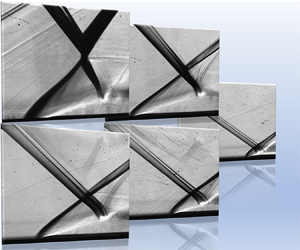Crossref Citations
This article has been cited by the following publications. This list is generated based on data provided by
Crossref.
Hu, Yan-Chao
Zhou, Wen-Feng
Yang, Yan-Guang
and
Tang, Zhi-Gong
2020.
Prediction of plateau and peak of pressure in a compression ramp flow with large separation.
Physics of Fluids,
Vol. 32,
Issue. 10,
Xue, Longsheng
Wang, Chengpeng
and
Cheng, Keming
2021.
A study on the RR-to-MR transition of shock wave reflections near the leading edge in hypersonic flows.
Journal of Fluid Mechanics,
Vol. 919,
Issue. ,
Xie, Wen-Zhong
Yang, Shu-Zi
Zeng, Cheng
Liao, Kai
Ding, Run-Han
Zhang, Lu
and
Guo, Shengmin
2021.
Improvement of the free-interaction theory for shock wave/turbulent boundary layer interactions.
Physics of Fluids,
Vol. 33,
Issue. 7,
Li, Xian-Dong
Yu, Yong-Liang
and
Bao, Lin
2021.
Theory-based prediction of separation angle and peak pressure for laminar separated hypersonic compression corner flows.
Physics of Fluids,
Vol. 33,
Issue. 8,
Cheng, Jianrui
Yang, Kai
Zheng, Xiaogang
Shi, Chongguang
Zhu, Chengxiang
and
You, Yancheng
2022.
Analytical model for predicting the length scale of shock/boundary layer interaction with curvature.
Physics of Fluids,
Vol. 34,
Issue. 11,
Zhu, Zi-yuan
Zhao, Yi-long
Zhao, Yu-xin
Wang, Li-can
and
Zhou, Yong-yi
2022.
Influence of expansion corner on the interaction of dual separation zones.
AIP Advances,
Vol. 12,
Issue. 12,
Timokhin, M.Yu.
Kudryavtsev, A.N.
and
Bondar, Ye.A.
2022.
The Mott-Smith solution to the regular shock reflection problem.
Journal of Fluid Mechanics,
Vol. 950,
Issue. ,
Xue, Longsheng
Jiao, Yun
Wang, Chengpeng
and
Cheng, Keming
2023.
Pressure plateau of separation induced by shock impingement in a Mach 5 flow.
Journal of Fluid Mechanics,
Vol. 972,
Issue. ,
Guo, Yunjie
Tan, Huijun
Zhang, Yue
Li, Xin
Xue, Hongchao
Luo, Ziqi
and
Huang, Hexia
2024.
On incident shock wave/boundary layer interactions under the influence of expansion corner.
Journal of Fluid Mechanics,
Vol. 988,
Issue. ,
Peng, Yuan
Xu, Jinglei
Chen, Kuangshi
and
Huang, Shuai
2024.
On the coupling effects of near-wall combustion and shock train in dual-mode scramjets.
Physics of Fluids,
Vol. 36,
Issue. 12,
Cheng, Jianrui
Zhang, Tao
Shi, Chongguang
Da, Xingya
Zhu, Chengxiang
and
You, Yancheng
2024.
Analytical reconstruction of axisymmetric curved shock wave/boundary layer interactions.
Physics of Fluids,
Vol. 36,
Issue. 4,
Jiao, Yun
Ma, Zhangyu
Xue, Longsheng
Wang, Chengpeng
Chen, Jianqiang
and
Cheng, Keming
2024.
Experimental study on the heat flux of transitional shock wave–boundary layer interaction at Mach 6.
Acta Astronautica,
Vol. 219,
Issue. ,
p.
353.
Scharnowski, S.
Baidya, R.
and
Kähler, C. J.
2025.
Characterizing the transition between regular and Mach reflections induced by a shock wave–boundary layer interaction.
Shock Waves,
Vol. 35,
Issue. 2,
p.
125.
Pu, Jingqian
Guan, Ben
Deng, Zhiwei
Zhai, Zhigang
and
Luo, Xisheng
2025.
Quasi-steady shock refraction phenomenon at a diffusive fast–slow interface.
Journal of Fluid Mechanics,
Vol. 1010,
Issue. ,
Zhang, Yaowen
Wang, Shaozhan
Yang, Dangguo
and
Dong, Bin
2025.
Numerical Study on the Influence of Suction near Expansion Corner on Separation Bubble.
Aerospace,
Vol. 12,
Issue. 2,
p.
89.
Chen, Huifeng
Tang, Tao
Yang, Yixin
Sun, Mingbo
Long, Wenxiao
Dong, Zeyu
Wang, Hongbo
and
Xiong, Dapeng
2025.
Turbulent boundary layer separation in supersonic S-shaped pipes with different flow turning angles.
Physics of Fluids,
Vol. 37,
Issue. 5,
Lin, Yujing
Liu, Weidong
Wei, Feng
Yu, Jiangfei
Yue, Xiaofei
and
Hu, Yufa
2025.
An experimental investigation of heat transfer phenomena in shock wave/boundary layer interaction at Mach 6.
Aerospace Science and Technology,
Vol. 158,
Issue. ,
p.
109936.

 $9^\circ$ to
$9^\circ$ to  $21^\circ$. The proposed theoretical method couples the free interaction theory (FIT) with the minimum entropy production (MEP) principle to predict the appearance of separation shock, resulting in convex, straight and concave separation shock waves according to different solution combinations, which agree well with current experiments. Additionally, several influences on SWBLI are studied experimentally, in which the parameters related to theoretical solutions are found mostly determining the flow configuration, and SWBLI is much more sensitive to incident shock strength than incoming flow properties. Separation could be suppressed by incident shock when the MEP solution is smaller than the FIT, while it could be intensified when the MEP solution is larger than FIT; by contrast, the effects of separation position and model mounting height could be very weak.
$21^\circ$. The proposed theoretical method couples the free interaction theory (FIT) with the minimum entropy production (MEP) principle to predict the appearance of separation shock, resulting in convex, straight and concave separation shock waves according to different solution combinations, which agree well with current experiments. Additionally, several influences on SWBLI are studied experimentally, in which the parameters related to theoretical solutions are found mostly determining the flow configuration, and SWBLI is much more sensitive to incident shock strength than incoming flow properties. Separation could be suppressed by incident shock when the MEP solution is smaller than the FIT, while it could be intensified when the MEP solution is larger than FIT; by contrast, the effects of separation position and model mounting height could be very weak.